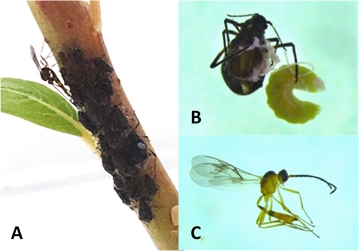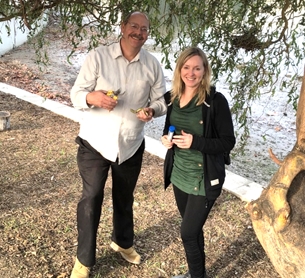PESTS AND DISEASES OF FORESTRY IN NEW ZEALAND
Trojan aphids used to import parasitoids
Scion is the leading provider of forest-related knowledge in New Zealand
Formerly known as the Forest Research Institute, Scion has been a leader in research relating to forest health for over 50 years. The Rotorua-based Crown Research Institute continues to provide science that will protect all forests from damage caused by insect pests, pathogens and weeds. The information presented below arises from these research activities.
From Forest Health News 278, January 2018.
After two attempts, the braconid parasitoid, Pauesia sp., has been successfully imported into Scion’s containment facility in Rotorua. Pauesia sp. is a potential biological control agent for giant willow aphid (GWA; Tuberolachnus salignus) in New Zealand, and is being investigated as part of MPI’s Sustainable Farming Fund project: Management of Giant Willow Aphid.
This parasitoid naturally occurs with populations of GWA in other parts of the world. It kills the aphids by laying a single egg inside each aphid (Fig. 1A). When the egg hatches the developing larva consumes the aphid from the inside (Fig. 1B). Later, the aphid dies and becomes ‘mummified’ (immobile and swollen) and soon after an adult wasp emerges (Fig. 1C).

A 2016 scouting trip determined four locations in California where GWA was present and revealed evidence of parasitism at two of these. However, the level of parasitism occurring in GWA, the life cycle of the wasp, and even its specific name are all unknown. Thus efforts to import Pauesia sp. were somewhat of a risk, and our first attempt at importation from California in October 2017 was unsuccessful.
We did not know whether the imported aphids contained any wasp larvae because the aphids died quickly after import, apparently unable to live on the fresh spring willow shoots we provided as food. This was a learning process for us and may relate to the difficulty of finding GWA in the natural environment in springtime. Another factor was the struggle to find large numbers of aphids in California where they are very scarce, presumably in part because they are kept in check by the parasitoid.
With the scarcity of GWA in the USA in mind, citizen science was employed to enlist keen Californians to help find populations of aphids for a future import. Through iNaturalist we contacted professional and amateur ecologists that had previously recorded seeing GWA, and some that had recorded willow. As a result of this call for help, and with the assistance of collaborators from the USDA Forest Service, a much greater number of aphids were collected on the second attempt in December 2017 (Fig. 2).

Approximately 900 aphids were collected, and from these, 34 Pauesia sp. emerged, some during transit across the Pacific Ocean inside a secure chilly bin. Only 10 were females, but these gave rise to almost 500 new individuals when reared on NZ GWA. This first ‘New Zealand born’ generation began to emerge on New Year’s Day with a second generation emerging by late January. We are currently learning about their life cycle and behaviour in preparation for non-target host specificity testing to ensure the safety of other species of aphids in New Zealand, should Pauesia sp. eventually be released into the New Zealand environment.
Stephanie Sopow (Scion)
This information is intended for general interest only. It is not intended to be a substitute for specific specialist advice on any matter and should not be relied on for that purpose. Scion will not be liable for any direct, indirect, incidental, special, consequential or exemplary damages, loss of profits, or any other intangible losses that result from using the information provided on this site.
(Scion is the trading name of the New Zealand Forest Research Institute Limited.)

 Farm Forestry New Zealand
Farm Forestry New Zealand

